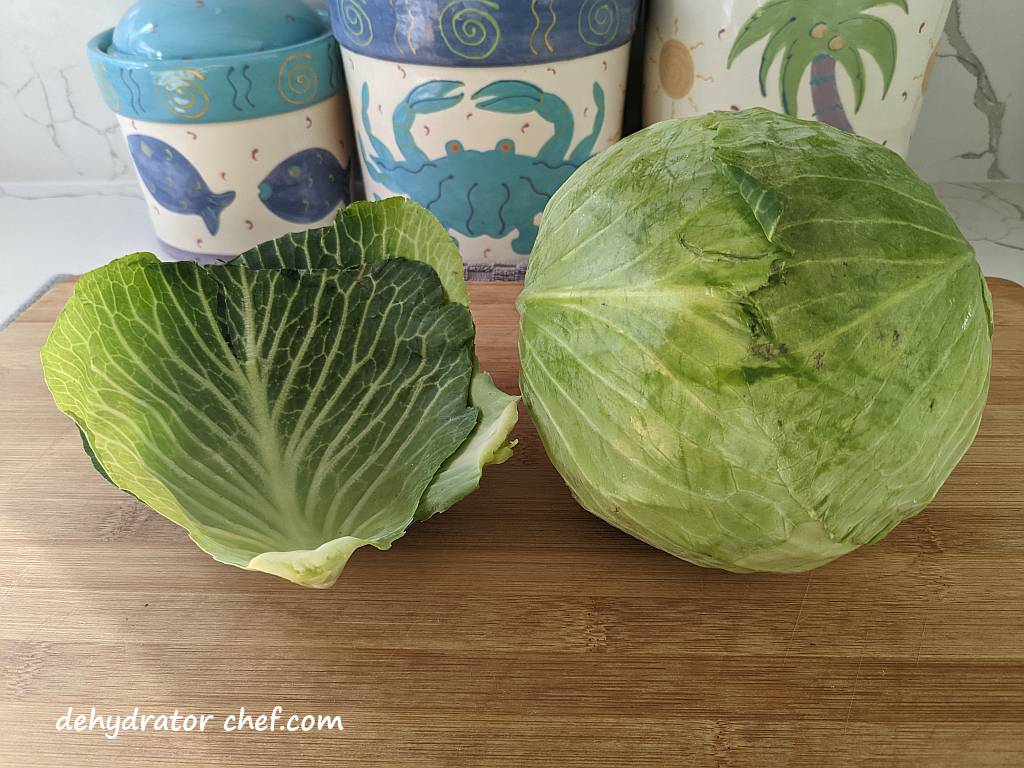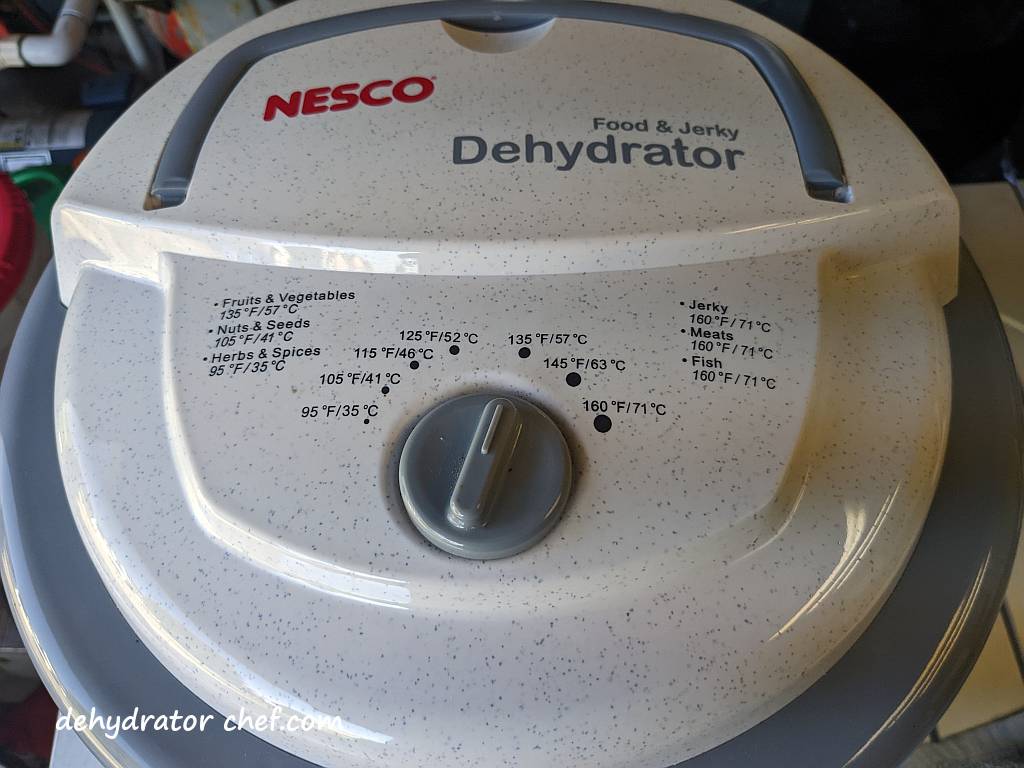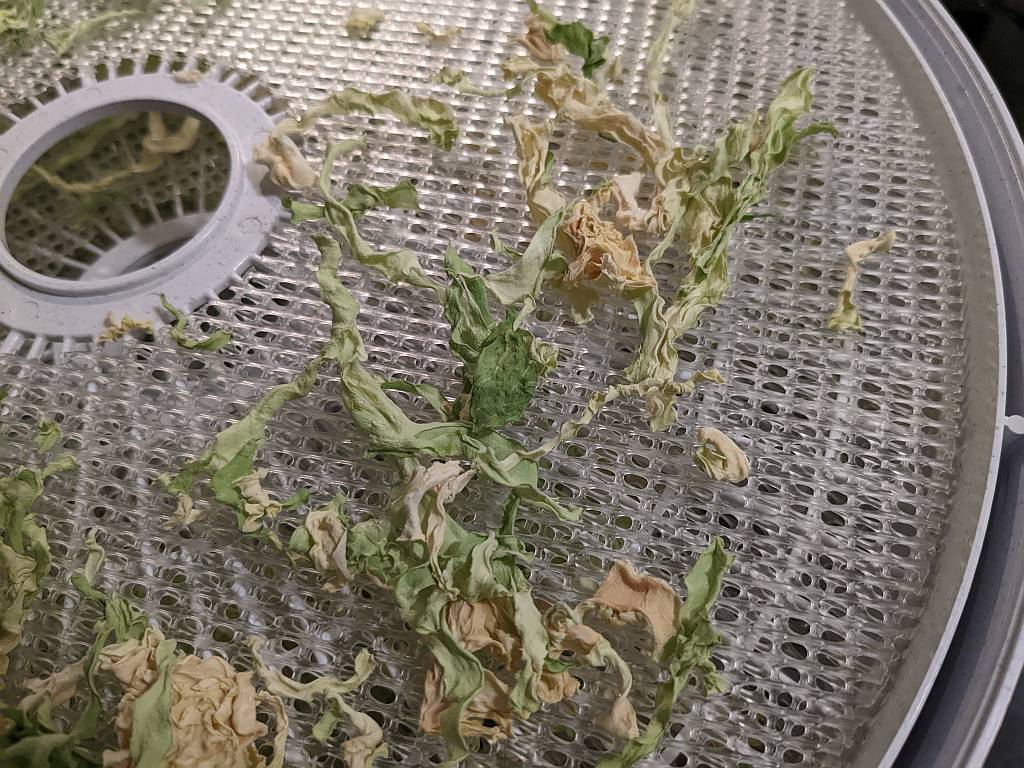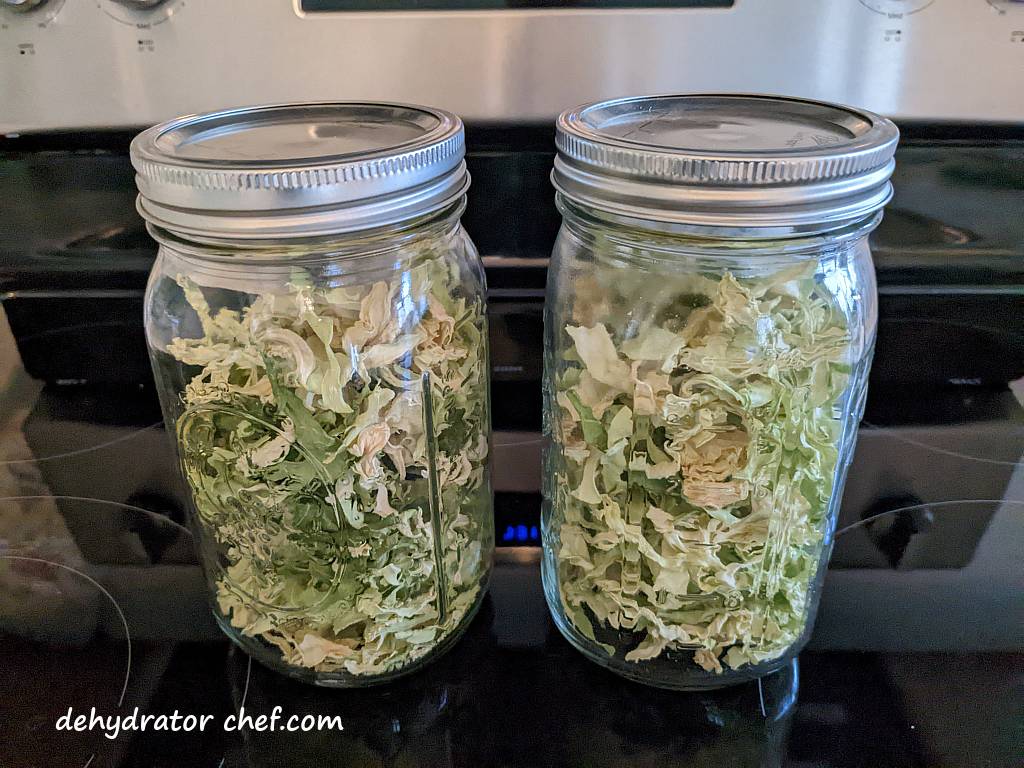This is our step-by-step guide on how to dehydrate cabbage. Dehydrating cabbage is really easy to do and a great first project. Cabbage dehydrates well and takes little preparation. It also easily hydrates.
For this project, we’re focusing on dehydrating green cabbages since we use them the most. We have a couple of recipes that call for dehydrated cabbage that we will put in the recipes section.
Cabbage belongs to the Brassica family of vegetables, which includes broccoli, radishes, and Brussels sprouts. It’s loaded with vitamins, minerals, antioxidants, and gut-friendly soluble and insoluble fiber. Cabbage has other health benefits, too many to list here. So, what is not to like?
You can also supplement those store-bought freeze-dried meals with dehydrated cabbage and your other dehydrator projects.
So, let’s get started dehydrating cabbage.
Table of Contents
- How to Dehydrate Cabbage
- Supplies Needed to Dehydrate Cabbage
- Step 1. Process the Green Cabbage for Dehydrating
- Step 2. Preparing the Dehydrator to Dehydrate Cabbage
- Step 3. Dehydrating Cabbage
- Step 4. When is the Dehydrated Cabbage Done
- Step 5. Equalizing and Conditioning of the Dehydrated Cabbage
- Step 6. Storing the Dehydrated Cabbage
- Hydration
- Weights, Measures, and Serving Sizes
- Insider Tips
How to Dehydrate Cabbage
Choose a green cabbage that seems solid and heavy for its size. The perfect green cabbage should have leaves that are tightly packed around the head and without gouges. Look for one without the floppy leaves hanging off since you will just compost those. It should be fresh-looking and green in color. There should be no wilted or discolored leaves.

For planning, a 2-1/2 to 3-pound green cabbage fills 5 Nesco 13.5-inch round dehydrator trays. So start with one on the smaller side, about 2-1/2 to 3 pounds, and go from there and see how everything fits in your dehydrator.
All you need to dehydrate cabbage is a good quality food dehydrator. We use the Nesco FD-61, and you can check out our food dehydrator guide here and why we think Nesco offers the best bang for the buck.
Supplies Needed to Dehydrate Cabbage
- Garden-fresh or store-bought green cabbages
- Common kitchen tools such as cutting boards, chef’s knives, colander, etc.
- Food dehydrator, with removable mesh inserts for the dehydrator trays
- Clear canning jars for storage
- Wide-mouth canning jar funnel
Step 1. Process the Green Cabbage for Dehydrating
First, peel off the outer leaves.
Next, quarter the cabbage, then remove the core with a diagonal cut.

I’ll rinse the cabbage quarters in a colander under cold running water. Then, shake off the excess water.
Finally, cut the quarters into slices. Anywhere between 1/4 inch to 1/2 inch is fine. There is no need to process them any further. Blanching the cabbage is not necessary. Easy enough.
Step 2. Preparing the Dehydrator to Dehydrate Cabbage
We will use the removable mesh screen inserts on our Nesco FD-61 food dehydrator. They have over 2700 customer reviews with an average rating of 4.7 stars out of 5, which is evidence of a great product. Check out other Nesco food dehydrator products here.

Evenly spread out and layer the sliced cabbage onto the dehydrator trays.

The Nesco FD-61 food dehydrator tray has close to 119 square inches or .8 square feet of surface area for drying.
A 2-1/2 to 3-pound green cabbage filled up 5 of my Nesco 13.5-inch round dehydrator trays.

Step 3. Dehydrating Cabbage
To save time, you can start dehydrating the cabbage by setting the initial drying temperature to 160 °F / 71 °C for 2 hours. Then, dial the temperature back to 135 °F / 57 °C until dry.
I find that 20 to 24 hours is about the right amount of time. Cabbage has a lot of water content.
Of course, it’s all dependent on your food dehydrator, the ambient temperature and humidity, and how crowded you fill your trays. Remember to use drying times as a guide.

Step 4. When is the Dehydrated Cabbage Done
After 20 to 24 hours, the cabbage should be fully dehydrated. If not, let it go another several hours and check again.

Drying times will vary depending on your dehydrator. Refer to your dehydrator owner’s manual for recommended temperatures and times for dehydrating specific foods. Remember to use drying times as a guide.

Warm cabbage still in the food dehydrator will feel somewhat pliable and you may believe they need more drying time. Simply unplug the dehydrator and let everything cool down. Then check again to be sure. They should be crisp or brittle when done.
Step 5. Equalizing and Conditioning of the Dehydrated Cabbage
We always recommend letting food items cool completely after they have finished dehydrating and before packing them into an airtight storage container for equalizing and conditioning. Warm food may cause sweating, which could provide enough moisture for mold to grow.

It does not take long for dehydrated food items to start hydrating from ambient household humidity. Do not leave dehydrated food items exposed to the elements any longer than necessary because of the increased risk of mold growth.
After a short cooling period, loosely pack the dehydrated cabbage into a clean, dry, insect-proof, and airtight storage container. We use the larger quart-size canning jars for conditioning. Since the canning jars are clear, it’s easy to see what’s inside.
When the dehydrated cabbage slices are removed from the dehydrator, the remaining moisture may not be distributed equally among all of the pieces because of their size, location, and position in the dehydrator. Equalizing and conditioning is a procedure used for freshly dehydrated foods that ensures any residual moisture remaining in any piece is spread or equalized among all the other pieces in the batch. Let the dried cabbage equalize and condition in the storage container for 7 to 10 days.
Every day, check the jar for moisture. Roll the jar contents around and note any clumping or sticking. If seen, put the contents back on the dehydrator for several more hours. Since canning jars are clear, it’s easy to see what’s inside.
A quality stainless steel or plastic canning funnel makes the messy job of getting dehydrated foods off the dehydrator tray and into the canning jars or spice grinder an easy task. Take a minute or two and check them out here on Amazon.
If you notice any mold at all, even the smallest bit, throw it all out. What you see are the mold spores finally blooming enough to make them visible. But there are more, even tinier mold spores in the rest of your jar that make your dehydrated food inedible. Toss it out and start another batch.
Step 6. Storing the Dehydrated Cabbage
Use an appropriately sized canning jar for storage. The dehydrated cabbage might keep up to 12 months. Exactly how long depends on how well you dehydrate the cabbage and your pantry storage conditions.
We’ll use a food-safe moisture-absorbing desiccant packet for moisture control because we live in a fairly humid area. For our pint-size or quart-size mason jars, we’ll use a single food-safe 5-gram desiccant packet.

We use these inexpensive food-safe desiccant packets, which are available from Amazon. These 5-gram packets have over 5000 of mostly 4- and 5-star customer reviews, with an average of 4.7 stars out of 5. Our bag of 60 desiccant packets will last quite a while because they can be recharged and reused multiple times. Other food-safe sizes are available.
Lastly, attach or include a short note describing the jar contents and the date the product was dehydrated. The note also informs us where to go in the dehydrator logbook to make an update.
Hydration
Dried cabbage will easily hydrate with cold or warm water.
For best results, hydrate the dried cabbage using a 1-to-1 ratio of dehydrated cabbage to boiled water. Plan on at least 15 to 20 minutes to fully hydrate.
If you’re supplementing store-bought freeze-dried meals as we do, just add a bit more boiling water to the food pouch. Use the same 1-to-1 ratio of dehydrated cabbage to water and account for the extra time. Optionally, hydrate the dried cabbage separately, drain the excess water, and then mix.
Weights, Measures, and Serving Sizes
This information is from a recent entry from the notes we keep on most of our food dehydration efforts.
Two of the outer leaves of the cabbage weighed 53 grams. This was before I quartered it for processing. After the 2 leaves were dehydrated, they weighed in at 4 grams.
Quartered and cored, the entire cabbage weighed almost 2 pounds and 6 ounces. More specifically, it weighed 1068 grams.
Dehydrated, the cabbage weighed just under 3 ounces or 75 grams. So that is quite a bit of water loss and savings in weight.
For planning purposes, a 2-1/2 to 3-pound green cabbage, once dehydrated, filled up 2 of the 1-quart canning jars.
Insider Tips
Besides dehydrated meal recipes found here, add dehydrated cabbage to any of your favorite freeze-dried food pouches for a bit more bulk. I don’t know about you, but with some of those store-bought freeze-dried meals, I am still hungry. I need a bit more to fill me up.
Just be sure to compensate by adding additional boiled water in a 1-to-1 ratio to the freeze-dried meal and allow enough time for adequate hydration. Or just hydrate the dried cabbage separately.
